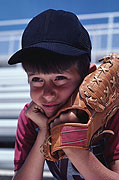
SATURDAY, April 4, 2015 (HealthDay News) — Being able to play baseball year-round puts young pitchers in the southern United States at increased risk for an overuse injury in their throwing arm, a new study finds.
University of Florida researchers looked at college baseball players and found that those who play in the South are 5.5 percent more likely to suffer an ulnar collateral ligament tear in the elbow in their throwing arm than those in other parts of the country.
The investigators also found that high school pitchers in the South are 6.2 percent more likely to suffer that type of injury than those in the North.
The study is scheduled for presentation at the annual meeting of the American Medical Society for Sports Medicine, April 14 to 19 in Hollywood, Fla.
“The old adage isn’t necessarily correct: that more is better. The more is leading to overuse injuries,” lead author Dr. Jason Zaremski, an assistant professor of orthopedics and rehabilitation in the UF College of Medicine, said in a university news release.
He and his colleagues said the findings can help coaches and young players understand the risks of overuse. Some professional baseball players who suffer an ulnar collateral ligament tear may have started to have symptoms in high school or earlier, Zaremski explained.
“This is an injury that should not be happening at our high school level or even collegiate level,” he said. “This is a preventable injury. If we can get to these baseball players and pitchers at a younger age and educate them on the risk of playing through pain, if it’s their throwing elbow or shoulder, I suspect we can decrease the amount of these injuries.”
Other experts agree.
“The spike we’ve seen [in such injuries] over the last 10 years closely correlates to the beginning of baseball showcases, year-round baseball travel teams and playing on multiple teams,” study senior author Dr. Kevin Farmer, team physician for the UF Athletic Association, said in the news release.
The sports medicine doctors also said parents should pay attention to who’s running their children’s athletic activities.
“Often, parents and coaches are only focusing on the injury at the collegiate level and that’s too late,” study second author MaryBeth Horodyski, a professor and director of research in the department of orthopedics and rehabilitation, said in the news release.
“You don’t drop your kid off at the swimming pool without a lifeguard there. When you drop off your kid at other sports, who’s making sure their injuries are being taken care of properly?” she said.
Even high school teams should have a licensed athletic trainer at their practices, and their coaches should be trained to recognize practice habits that lead to overuse injuries, Horodyski said.
Data and conclusions presented at meetings are usually considered preliminary until published in a peer-reviewed medical journal.
More information
The U.S. National Institute of Arthritis and Musculoskeletal and Skin Diseases has more about children and sports injuries.
Copyright © 2025 HealthDay. All rights reserved.

